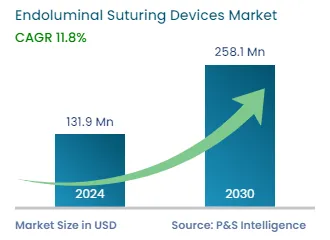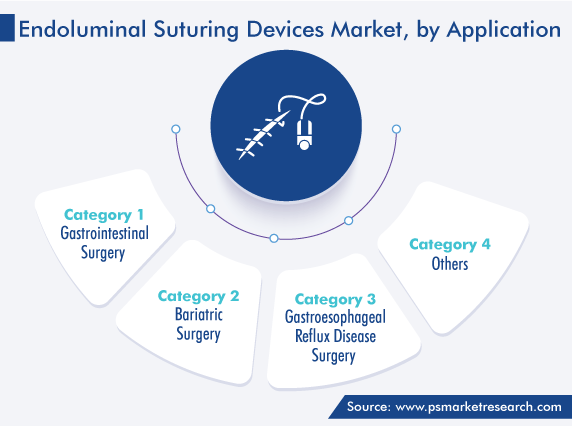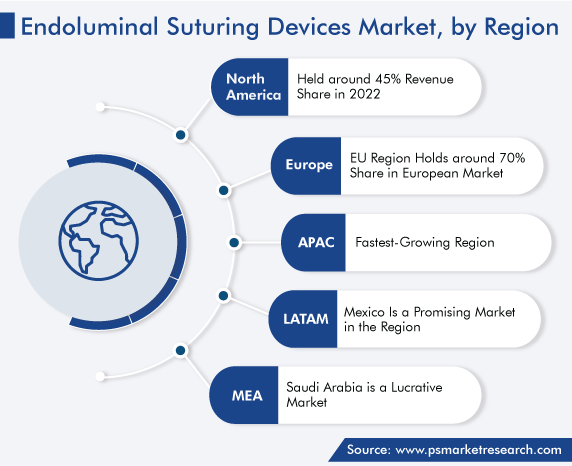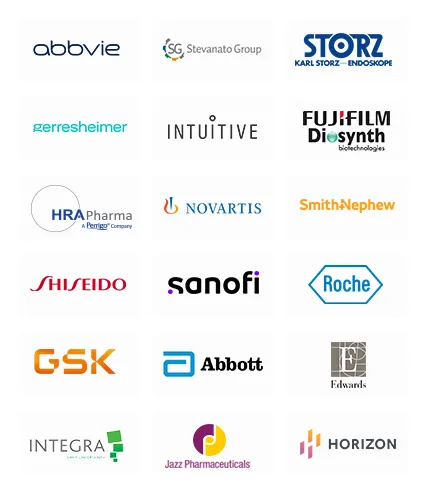Market Statistics
| Study Period | 2019 - 2030 |
| 2024 Market Size | USD 131.9 Million |
| 2030 Forecast | USD 258.1 Million |
| Growth Rate(CAGR) | 11.8% |
| Largest Region | North America |
| Fastest Growing Region | Asia-Pacific |
| Nature of the Market | Fragmented |
Report Code: 12523
Get a Comprehensive Overview of the Endoluminal Suturing Devices Market Report Prepared by P&S Intelligence, Segmented by Application (Bariatric Surgery, Gastrointestinal Surgery, Gastroesophageal Reflux Disease Surgery), Component (Suction Port, Cannula, Needle), End User (Hospitals, Clinics, Ambulatory Surgery Centers), and Geographic Regions. This Report Provides Insights From 2019 to 2030.
| Study Period | 2019 - 2030 |
| 2024 Market Size | USD 131.9 Million |
| 2030 Forecast | USD 258.1 Million |
| Growth Rate(CAGR) | 11.8% |
| Largest Region | North America |
| Fastest Growing Region | Asia-Pacific |
| Nature of the Market | Fragmented |

Explore the market potential with our data-driven report
The global endoluminal suturing devices market was valued at USD 131.9 million in 2024, which is expected to reach USD 258.1 million by 2030, growing at a CAGR of 11.8% during 2024-2030. This is attributed to the rise in popularity of minimally invasive weight loss procedures and the increase in the prevalence of lifestyle-associated diseases.
A sedentary lifestyle, poor diet, and increased inclination toward alcoholism and tobacco consumption have led to a surge in cases of obesity, inflammatory bowel diseases, and gastrointestinal illnesses, among others. Moreover, the prevalence of chronic conditions such as cancer has given a boost to the sector.
Clinicians and other healthcare professionals are now exploring different procedures used for weight loss as well as GIT surgeries because of the newer interventions and technological enhancements in endoluminal instruments. The operation with their use avoids the need for open surgery as they are able to get rid of lesions without it; on top of that, they provide greater patient satisfaction, quicker healing, fewer hospital visits, and shorter hospital stays. These aforesaid advantages generate traction for this industry and prove to be highly lucrative.
There has been a significant rise in popularity in this field because there has been the introduction of robotic suturing systems. For endoluminal procedures, the use of robotic arms enables surgeons to mimic manual human wrist movement, considerably reducing mistakes. Additionally, this technique offers surgeons with robotic arm flexibility as well as three-dimensional vision. As a result, the aforementioned reasons are both boosting the need for these devices and improving surgical results.
The notable prevalence of GIT conditions, such as heartburn, acid reflux, and bloating, drives the consumer demand for minimally invasive procedures. Furthermore, as per recent studies, there will be a boom in these conditions in the near future among the majority of adults. This consequently would result in the success of this sector.
Players in this industry have a lot of room for expansion in developing nations like Brazil, China, India, and Mexico. Due to the accelerated development of medical infrastructure, a rise in public and private healthcare spending, and an increase in , this sector offers several opportunities to players. The expansion in total demand is further aided by an increase in the number of highly trained surgeons and gastrointestinal surgeries performed in these countries.
Moreover, the development of healthcare infrastructure and fast modernization of medical institutions are also occurring in developing nations, which, in turn, influence the uprising purchase of medical equipment and surgical supplies. In addition, due to the affordable treatment choices for operations available in emerging regions, medical tourism is on the rise. This creates new growth opportunities for major players.
The rise in cases of chronic conditions and a continuous increase in the geriatric population base are primarily driving the market success. This is because older people have weakened immune systems and they become more vulnerable to such illnesses. In addition, there has been growth in government expenditure on medical facilities, in order to improve patient care, especially in emerging countries like India, China, and others.
These diseases are becoming dramatically more common as a result of unsafe choices such as poor food choices, inactivity, smoking, and ignoring obvious risks like family history. For instance, a larger proportion of Americans deal with long-term illnesses, which are persistent and typically incurable. According to research, nearly half of Americans today have at least such an ailment, for example, arthritis, hypertension, or heart disease. Thus, this factor drives the demand for endoluminal suturing systems.
Gastrointestinal Surgery Dominates the Industry
The gastrointestinal surgery category accounted for the largest revenue share, around 40%, in 2022. This is because there are more GI procedures performed every year and a wide range of GI-related conditions, like those that are related to the abdomen, are now treatable. The alimentary canal, oropharynx, biliary system, pancreas, liver, and other organs are all affected by this condition. According to a study conducted, it has been observed that a substantial number of people suffer from this ailment. As a result, procedures for the same have seen tremendous growth in demand.
Whereas, the gastroesophageal reflux disease surgery category is expected to witness the fastest growth in the coming years, advancing at a CAGR of over 14%. This can be due to robust technological enhancements and the growing incidence of gastroesophageal reflux. Esophagitis, adenocarcinoma, and others are just a few of the health hazards linked to this condition, which frequently necessitates lifetime therapy. As this surgery is one of the leading therapeutic options for this ailment, the category is likely to contribute significantly to the industry in the upcoming years.
Due to the inactivity and lazy lifestyle, indulgence in fast foods, and a rise in the prevalence of several diseases, people are increasingly facing issues with obesity and related problems. Obesity has become a life-threatening problem for people around the world; if not properly treated, it can even lead to death. Due to this reason, people are now turning toward bariatric surgeries in order to get rid of excessive weight and lead a healthier and happier life.
Different types of bariatric operations performed by clinicians include gastric bypass, gastric revisional, and others. According to the WHO, more than 1 billion individuals are obese and the number is still on the rise. In addition, by 2025, a large population of kids and adults will become unhealthy because they will fall into the overweight category.

Drive strategic growth with comprehensive market analysis
On the basis of regional analysis, the APAC market is projected to show the highest growth rate, over 13%, during the predicted time. This high pace can be contributed to an expanding medical infrastructure and the presence of a sizable population at risk for numerous chronic conditions. China and India are two economies in this region that contribute the major population share to the world. In addition, the rise in severe infectious diseases, in emerging countries like China and India, is increasing the demand for minimally invasive surgeries.
Gastrointestinal sickness is on the rise throughout this area, as a result of the increasing urbanization and many shifting environmental and lifestyle variables. Additionally, this issue has been brought on by aging, which can be physiological or pathological, and it is more common in elderly people aged 64 years and older. Therefore, age-related regulations and interventions are required. In order to develop effective treatment plans, administering GIS medications and conducting early tests for digestive disorders and gastric problems among older adults are becoming more important in clinical practices.
Top players are increasingly showing their interest in this area due to the spike in expenditure in the medical field by governments. For instance, in India, the national capital region (NCR) will receive 11 new government hospitals, including seven intensive care units, providing a substantial enhancement to the city's healthcare services. The Delhi government announced that four hospitals are almost built and will all be accessible to the general public by the end of 2023. With these new hospitals, the NCR healthcare system will have almost 10 thousand extra beds. Substantial enhancements like such in the medical field are likely to gain traction from major companies and investments from the same.
The European market accounts for a notable revenue share, globally. This is due to the surging demand for cardiovascular and orthopedic processes, the increasing digestive issues, and the rising number of senior citizens in the region. A considerable amount of the overall burden of digestive issues has been linked to alcohol use and other modifiable lifestyle variables.
Germany leads the European market, and it is expected to hold around 25% share by 2030. This leading position of the country is mainly on account of the fact that it is one of the biggest global hubs for medical devices, characterized by the presence of a large number of industry players, which helps increase the reach of the existing as well as newly launched advanced medical devices. Hence, it is also likely to be the fastest-growing market for these devices in the coming years. Moreover, the country is one of the largest exporters of such devices.
The French market is also expected to showcase significant growth during the forecast period. This is majorly ascribed to the widespread prevalence of chronic ailments, increasing number of strategic developments, new product launches, and growing geriatric population in the country.

This report offers deep insights into the endoluminal suturing devices industry, with size estimation for 2019 to 2030, the major drivers, restraints, trends and opportunities, and competitor analysis.
Based on Application
Based on Component
Based on End User
Geographical Analysis
The endoluminal suturing devices market size stood at USD 131.9 million in 2024.
During 2024–2030, the growth rate of the endoluminal suturing devices market will be 11.8%.
Gastrointestinal surgery is the largest application in the endoluminal suturing devices market.
The major drivers of the endoluminal suturing devices market include the rising number of surgeries, the increasing demand for minimally invasive operations, technological enhancements, and the surging prevalence of lifestyle-associated diseases.
Want a report tailored exactly to your business need?
Request CustomizationLeading companies across industries trust us to deliver data-driven insights and innovative solutions for their most critical decisions. From data-driven strategies to actionable insights, we empower the decision-makers who shape industries and define the future. From Fortune 500 companies to innovative startups, we are proud to partner with organisations that drive progress in their industries.


Working with P&S Intelligence and their team was an absolute pleasure – their awareness of timelines and commitment to value greatly contributed to our project's success. Eagerly anticipating future collaborations.
McKinsey & Company
IndiaOur insights into the minutest levels of the markets, including the latest trends and competitive landscape, give you all the answers you need to take your business to new heights
We take a cautious approach to protecting your personal and confidential information. Trust is the strongest bond that connects us and our clients, and trust we build by complying with all international and domestic data protection and privacy laws
Customize the Report to Align with Your Business Objectives
Request the Free Sample Pages